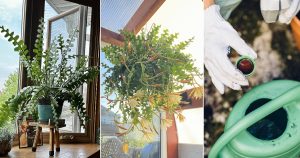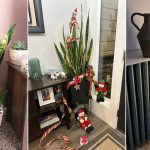Here is a complete guide on how to keep your Aloe vera thriving indoors all winter long with some interesting tips and tricks.
Aloe vera is a very popular houseplant, known for its fast-growing, resilient nature and healing properties. It grows and adapts to almost all kinds of climatic conditions. However, it can struggle a bit in extremely cold temperatures. This guide will show how to keep your Aloe vera thriving indoors throughout the winter season.
How to Keep Your Aloe Vera Thriving Indoors All Winter Long
1. Bright Light
Winter often brings dim, cloudy days, which can bring trouble to your plants at times. This can sometimes leave your Aloe vera starving for light because it enjoys bright light and sunny conditions. So, place it in bright locations in your home during the cooler months to ensure that it receives sufficient light.
Ideally, a south- or east-facing window is good. If natural light is insufficient, use an LED grow light to fill the gap.
Additionally, rotate your plant weekly so that it receives light from all sides and prevents it from leaning toward the light source.
2. Keep it Warm
Aloe vera thrives in warm, consistent temperatures. While most homes stay heated during winter, chilly drafts from windows and doors can harm your plant. For this, you can use draft stoppers or curtains to block cold air near the windows, because that is where your plants will be most of the time.
Another thing you can do is place the pot on a stand or tray filled with pebbles to insulate it from cold surfaces. Else, if you use a heater make sure it’s not blowing directly on the plant or it could dry out the leaves and cause damage.
3. Water Sparingly

Overwatering can be particularly harmful in the winter dormancy because Aloe vera plants usually require less water than usual. Allow the soil to dry out completely between waterings and be patient, it is normal for it to look a bit unlively during this time.
You can also try to stop adding fertilizer from the beginning of the fall season, this helps to prevent salt build up in the soil, which can harm the plant.
4. Mind the Humidity
Unlike some indoor plants that crave humidity, Aloe vera thrives in dry conditions. If your home feels too humid due to heaters or humidifiers, create airflow using a fan set on low. Alternatively, move your plant to a less humid room, such as a living room or bedroom.
Additionally, keep it away from kitchens and bathrooms, which tend to have higher humidity levels.
5. Choose the Right Pot and Soil
The pot and soil you use for your Aloe can make or break your plant during winter. Terracotta pots are ideal because they absorb excess moisture and allow the roots to breathe. Pair this with a well-draining soil mix containing sand or perlite.
Also, for better drainage, use a layer of gravel or pebbles at the bottom of the pot. You can choose other decorative pots if they offer to have a good drainage hole.
6. Pause the Fertilizer

In the cooler months, your Aloe vera is in a dormant phase and doesn’t actually need feeding. Rather, it can burn the roots and lead to weak growth and development. You can anyway resume fertilizing in the spring season using a diluted succulent fertilizer.
Fact: If your Aloe looks pale or weak despite good care, the issue is more likely related to watering than nutrients. This usually happens during the winter when it doesn’t receive enough sunlight and water.
7. Keep Monitoring for Pests and Diseases
The dry indoor air can attract pests like spider mites, mealybugs, and aphids in winter. Inspect your plant weekly, especially around the leaf bases and soil. If you observe any pests, wipe the leaves with a mild solution of soap and water or apply neem oil spray.
Otherwise, if the infection seems to be severe then you can repot the plant in fresh soil mix and a new pot.
Pro Tip: Sprinkle cinnamon powder on the soil to treat fungal growth if it appears to keep your plant extra safe!
8. Clean and Shine!
Dusting or wiping the foliage of your houseplants has a lot of benefits. The accumulated dust can hinder the full absorption of sunlight and hamper photosynthesis as well. So, just gently wipe the leaves with a clean damp cloth once a month to keep your plants healthy and happy.
You can also use a natural leaf shine for extra shine! Mix equal parts of milk and water and make a natural shine spray. Avoid harsh chemicals or oils as these can cause harm and stress out your plant.
What Temperature Is Too Low for Aloe Vera?
Aloe veras are not cold hardy plants and tend to weaken when temperatures drop below 50F for prolonged periods due to frost damage and hard freeze. They thrive best in warm climates, but exposure to cold temperatures can bring a certain amount of risk to their health.
Prolonged exposure to freezing temperatures can cause cellular damage within the leaves that further leads to discoloration, softening, and even plant death.
For best care, maintain indoor temperatures between 55°F and 80°F (13°C–27°C) during winter and always monitor your Aloe’s placement to avoid cold drafts near windows or doors.
Taking these steps for your Aloe vera in the winter will ensure that it remains healthy and fresh, and is ready to flourish when summer returns. Write to us if you have any doubts regarding your indoor Aloe veras!












